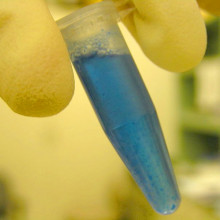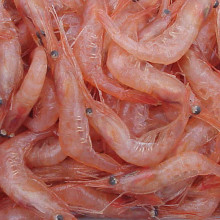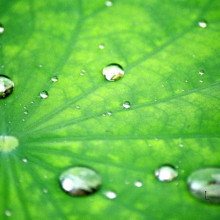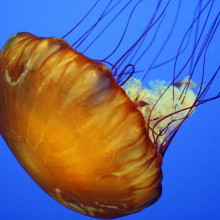This week, we hear how shrimp shells could catalyse biodiesel production, the physics behind regular raindrops and how blue food colouring could reduce the damage following spinal injury. Plus, science minister Lord Drayson explains why science is important at the opening of the Babraham Institute's new Bioscience Support Unit.
In this episode

Food dye at the spinal frontier
Scientists have discovered that a dye used to colour food can also help to heal spinal injuries. Writing in this week's PNAS, a team at the University of Rochester led by Maiken Nedergaard describe how a dose of Brilliant Blue G, an analogue of the food dye FD&C blue dye No. 1, can help rats with cord injuries to recover better than controls. The effect, say the team, is down to the ability of the dye to block a class of nerve transmitter receptors known as P2X7 receptors, which are present on spinal nerves and respond to chemical signals called purines, including one called ATP. Purines are released in large abundance during spinal injuries.
 When they lock onto P2X7 receptors a large pore is formed on the target nerve cell which allows large amounts of calcium and other potentially toxic substances to enter and kill the cell. This contributes significantly to what is known as "secondary damage" that often follows an injury and is responsible subsequently for a significant disability. The team had previously identified a chemical capable of blocking P2X7receptors, OxATP, which had shown promise in reducing spinal cord injury but it was highly toxic to other tissues, ruling out any therapeutic role for the agent. But this prompted the team to look for other substances capable of doing the same job, leading them to Brilliant Blue G (BBG). To test its effectiveness the team subjected experimental rats to spinal cord injuries.
When they lock onto P2X7 receptors a large pore is formed on the target nerve cell which allows large amounts of calcium and other potentially toxic substances to enter and kill the cell. This contributes significantly to what is known as "secondary damage" that often follows an injury and is responsible subsequently for a significant disability. The team had previously identified a chemical capable of blocking P2X7receptors, OxATP, which had shown promise in reducing spinal cord injury but it was highly toxic to other tissues, ruling out any therapeutic role for the agent. But this prompted the team to look for other substances capable of doing the same job, leading them to Brilliant Blue G (BBG). To test its effectiveness the team subjected experimental rats to spinal cord injuries.
Some of the animals received BBG whilst others were left untreated as controls. The researchers found that the BBG-treated animals began to recover sooner than the controls and regained superior function subsequently. And when the team compared the spinal cord tissue from the animals they found that the treated rats had significantly less secondary spinal tissue loss than the controls. The team point out that given the proven safety record of BBG this strategy could make a significant contribution to the management of spinal and other central nervous system injuries. At present, they point out, steroids like methyl prednisolone are about the best that doctors can offer a spinal injury patient. Steroids have modest benefit and work by reducing inflammation at the injury site but there is a delay before they begin to work. The effect of BBG is instantaneous, say the scientists, so it could have much to offer...

Put a shrimp in your tank
 You've heard of putting a tiger in your tank, but now how about putting a shrimp in your tank? Doesn't sound quite so impressive does it? But, that's exactly what scientists in China have been doing in an attempt to make biodiesel production more efficient.
You've heard of putting a tiger in your tank, but now how about putting a shrimp in your tank? Doesn't sound quite so impressive does it? But, that's exactly what scientists in China have been doing in an attempt to make biodiesel production more efficient.
XinshengZheng and colleagues from HuaZhong Agriculture University in Wuhan have discovered that shrimp shells could be a great improvement on the catalysts currently used to convert natural oils - from crops like soya,sunflowersand rapeseed - into diesel fuels for vehicles.
The use of biofuels is fraught with controversy. One possible way to get closer to a sustainable source of renewable fuel is to improve the yield of fuel per acre of crop.
Making biodiesel involves a process known as transesterification, which is essentially changes the chemical makeup of fatty acids in seed oils to convert them into a useable fuel. The reaction normally takes place very slowly, if at all, with the addition of a simple alcohol like methanol.
Traditionally it is speeded up and made more efficient by adding a catalyst in the form of a strong acid or base. The problem with these acid and base catalysts is they can't be reused and they involve the use of lots of water, another limited resource.
Now it seems shrimp shells could provide an alternative, more efficient catalyst that can be reused and doesn't need masses of water. Shrimp shell is made up mostly of chitin, the same stuff that our nails and hair are made of. By carbonizing - or burning - the shells and adding potassium fluoride,Zheng and the team made a catalyst which, after 3 hours, converted 89% of samples canola oil into biodiesel.
Shrimp shell make aparticularly good catalyst because is it's complex porous structure with dense honeycomblayers. With such a large internal surface area to the shell fragments there are lots of sites the oils come into contact with and where theesterification reaction will be speeded up, making the conversion to alcohol quicker and more complete.
The authors of the study, which appears in the journal Energy and Fuels, point out that shrimp shell is biodegradable and cheap, being a bi-product of the seafood industry. And while no-doubt the diofueldebate will rage on, they think this new finding could prove to be an important breakthrough in making biofuels more efficient and perhaps a bit less controversial.
Paper: Yang, L, Zhang, A., Zheng, X. 2009. Shrimp shell catalyst for biodiesel production. Energy & Fuels.

Raindrop sizes explained
In the nineteenth centuary scientists studying the weather looked at raindrop sizes, and discovered something quite interesting. There was quite a variation, most were less than 1mm across but a few were up to 5mm across, but for the same rate of rainfall the distribution was always the same.
This is strange as there are lots of ways in which rain can be created, at different heights and rates, depending on the clouds it is coming from. At the time it was thought that it was because big drops were crashing into one another and breaking apart. The problem is that there just aren't enough raindrops in the sky to crash into each other so scientists have remained confused.
Emmanuel Villermaux at Aix-Marseille University has probably worked out what is going on. There is a well known effect on fast moving droplets of diesel in an engine, where they flatten, then blow up to form a parachute shape and then pop to form smaller droplets.
This is an effect I noticed on a high speed video of our
water rockets kitchen science experiment. right at the end of this video, watch the last water droplet falling.
So they did some experiments and discovered that the distribution of droplets coming from one of these bubbles is exactly what you find in raindrops, so this may solve the century old mystery.
They have yet to see this process occurring with raindrops, put they are flying high speed cameras on planes looking for the events.

Jellyfish stirring things up.
Jellyfish may spend their lives passively drifting through the open oceans at the mercy of currents and tides, but they could also be stirring things up as they go.
 Together, all the swimming things in the oceans - including minute plankton - could contribute as much mixing as the winds and tides. That's according to KakaniKatijaand JohnDabiri from the California Institute of Technology in Pasadena who's study appeared this week in the journal Nature. It could mean that climate modelers have been missing an important part of the puzzle.
Together, all the swimming things in the oceans - including minute plankton - could contribute as much mixing as the winds and tides. That's according to KakaniKatijaand JohnDabiri from the California Institute of Technology in Pasadena who's study appeared this week in the journal Nature. It could mean that climate modelers have been missing an important part of the puzzle.
Katija and Dabiriused computer models to investigate a process in which a body moving through a fluid pulls some of that fluid with it. The more sticky or viscous the fluid is, the more of it is pulled along. This was an idea first reported 50 years ago by Charles Darwin - grandson of famous author of On the Origin of Species.
The computer models showed that a tiny plankton pulls up to four times its volume in water by just moving a few body lengths.
The research duo then set off for Palau, a cluster of beautiful tropical islands in the Pacific, to test out their ideas among swarms of real jellyfish: a very sensible choice because there jellyfish living in land-locked marine lakes have evolved to have no sting.
They squirted luminous dye behind of the jellyfish and filmed them using special laser-equipped underwater cameras. They watched as each jellyfish was followed by a trail of glowing dye. It turns out that up to 90% of the water movement came down to Darwin's theory and not because of a turbulent wake streaming behind the jellyfish.
The big question now is how this translates to a global scale, but there are important implications. A huge proportion of carbon dioxide emissions are absorbed by the oceans, both dissolving into the water and captured by planktonicplantlife. If animals swimming around are making a significant contribution to mixing up layers of the ocean this could be a major part of the climate equation that so far has been overlooked.
Oceanographer William Dewar writes an interesting commentary of this study in the same edition of Nature. He points how extraordinary it is that these processes acting at a tiny scale of mm and cm may have an affect on the vast oceans across hundreds of thousands of kms. Also, it is extraordinarily calm once you get down a short way into the oceans. All you would need is an electric kitchen hand-held mixer to stir up a cubic kilometer of sub-surface ocean. So, the jellyfish could be making a real difference down there.

13:13 - State of the art facility opens at the Babraham Institute
State of the art facility opens at the Babraham Institute
Lord Drayson, Science Minister
Chris - Now, also on the news this week, the Babraham Institute, which is located just outside Cambridge, has opened a new laboratory, and so we sent Ben Valsler down there to attend the opening and also find out what was going on. He's with us to tell us a bit about it now. Hello, Ben?
Ben - Hello.
Chris - So what was this new centre about?
Ben - Well, this is the Institute's new Bioscience Support Unit. It cost £17 million to build and a further £5 million to equip. And it contains some state-of-the-art technology, including some funky robots that I was watching. The Babraham Institute itself researches various biological mechanisms - how they work, how they sometimes go wrong. And this gives us some insight into things like the causes of cancer, the causes of heart disease and actually the way that we age as well. Now this sort of research underpins development of new therapies and this new Bioscience Support Unit will not only make the research easier and more accurate and quicker but it's actually designed in such a way to be really flexible, which makes the whole thing future-proof and should secure that investment for a good while yet. The Babraham Institute itself is funded by the BBSRC, that's the Biotechnology and Biological Sciences Research Council. They get their money from the UK government and Lord Drayson, who's the science minister, was there to open the unit. Twenty-two million pounds is a lot of investment especially during a financial crisis like this one but he believes that science is a priority.
Lord Drayson - Science is vitally important to the UK, in part, because one has to ask the question, given the way in which the world is developing, given the UK's position in 2009 in that world, what are the things which the UK is going to be particularly good at? What is it we're going to earn our living in, as a country? And the answer to that has to be science and the commercialisation of science, in terms of innovative new products and services. We can't succeed as a nation by competing on this, if you like, low-tech side of life. Our contribution has to be from those areas where the intellectual contribution that the in-depth understanding that we have shown over the decades Britain is particularly good at, is our future. So my job as Science Minister is to raise the profile of science, to make heroes out of scientists and science entrepreneurs; to get the general public, who sometimes see science as a bit of an elitist endeavour,  something that is done by a group of brainy people but it doesn't really affect them; to understand that we, as a nation, have to be both scientifically literate, because science is going to be so important to our futures, but also comfortable in discussing some of the big issues in science. And if we can do that, we can continue being a world leader in science and if we maintain our position as world leader in science, we will have probably the happy and prosperous society.
something that is done by a group of brainy people but it doesn't really affect them; to understand that we, as a nation, have to be both scientifically literate, because science is going to be so important to our futures, but also comfortable in discussing some of the big issues in science. And if we can do that, we can continue being a world leader in science and if we maintain our position as world leader in science, we will have probably the happy and prosperous society.
Ben - Lord Drayson also commended the Babraham Institute for engaging local schools and the wider community because having a future-proof research facility is only any good if we have a good supply of future scientists. He said that there's one clear way to stay competitive in science in the future...
Lord Drayson - Continue to invest in it and maintain our focus on excellence and making sure that we're maintaining a strong pipeline of young people coming through from the schools who get excited by science at school; that science enthusiasm maintained as they're growing up, studying at science universities and coming through to be the next generation of leading scientific researchers. If you can develop a sort of scientific approach to living life, of noticing things and asking questions: why is that like that? Even at the most, if you like, most mundane level.
I mean, the thing that fascinating me as the science minister is that when you get to meet really brilliant scientists it's often something early in their life that they noticed which actually got them switched on to science. The more we can get people to make that switch go on, the more likely we'll have a positive pipeline of young scientists coming to look forward and that's going to be very important to our success as a country.
Ben - So it now seems that doing Kitchen Science experiments with your children is both fun and it's patriotic! That was Lord Drayson at the opening of the Babraham Institute's new Bioscience Support Unit.
Chris - It's pretty impressive you've got to talk to him. I think it was fantastic.
Ben - I was quite honoured though and he was really nice and he was very down to Earth. I didn't get the impression that, you know, he was there to see the little people at the opening, but he was very much with us, very much supporting what they were doing, very much supporting science in the UK.
Chris - Thank you very much. That was Ben Valsler who went down to the Babraham Institute when they opened the new facility this week.
Related Content
- Previous The WCSJ Summary
- Next Tattoos Forever










Comments
Add a comment